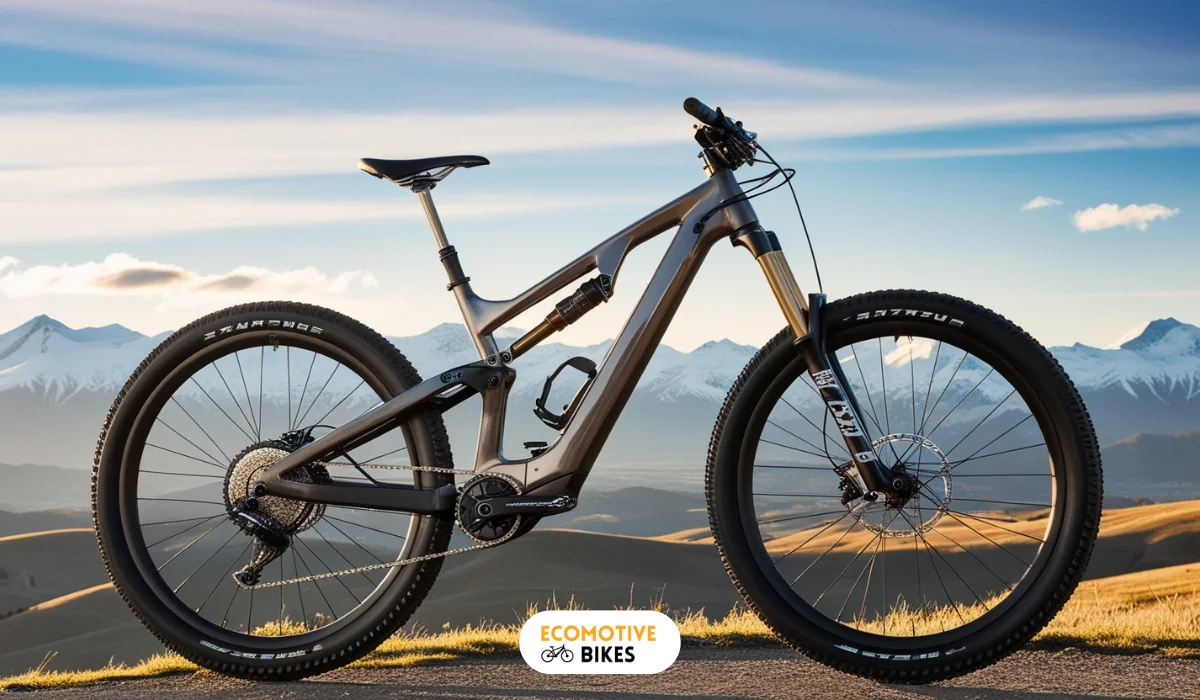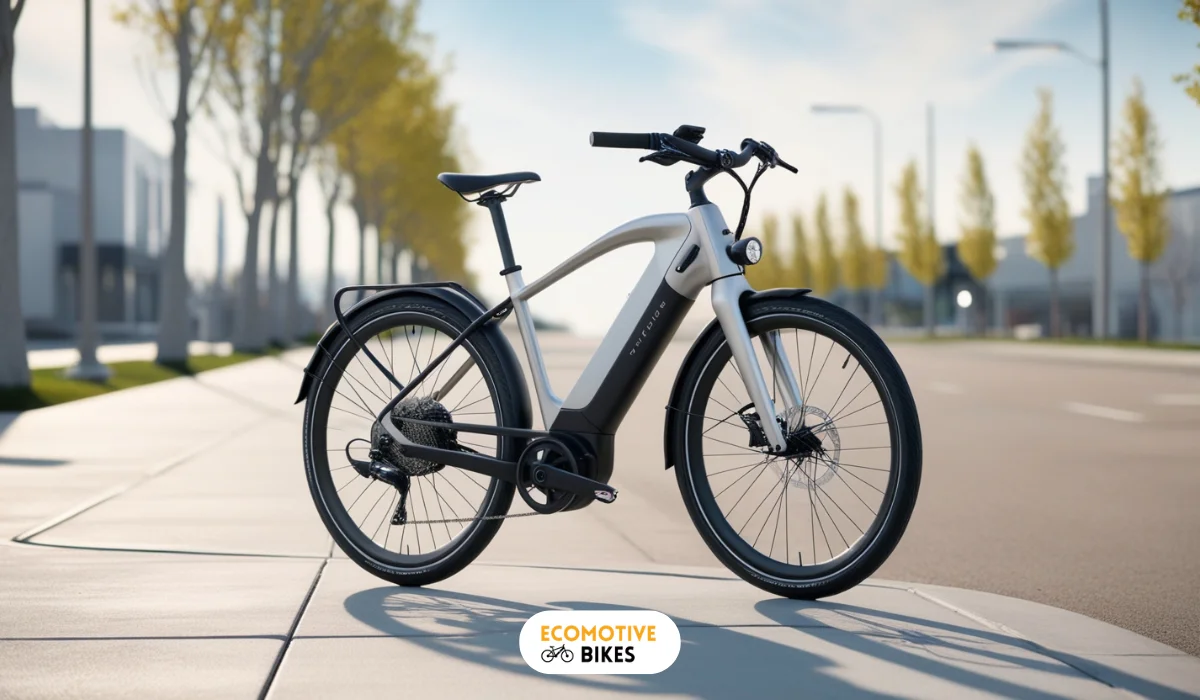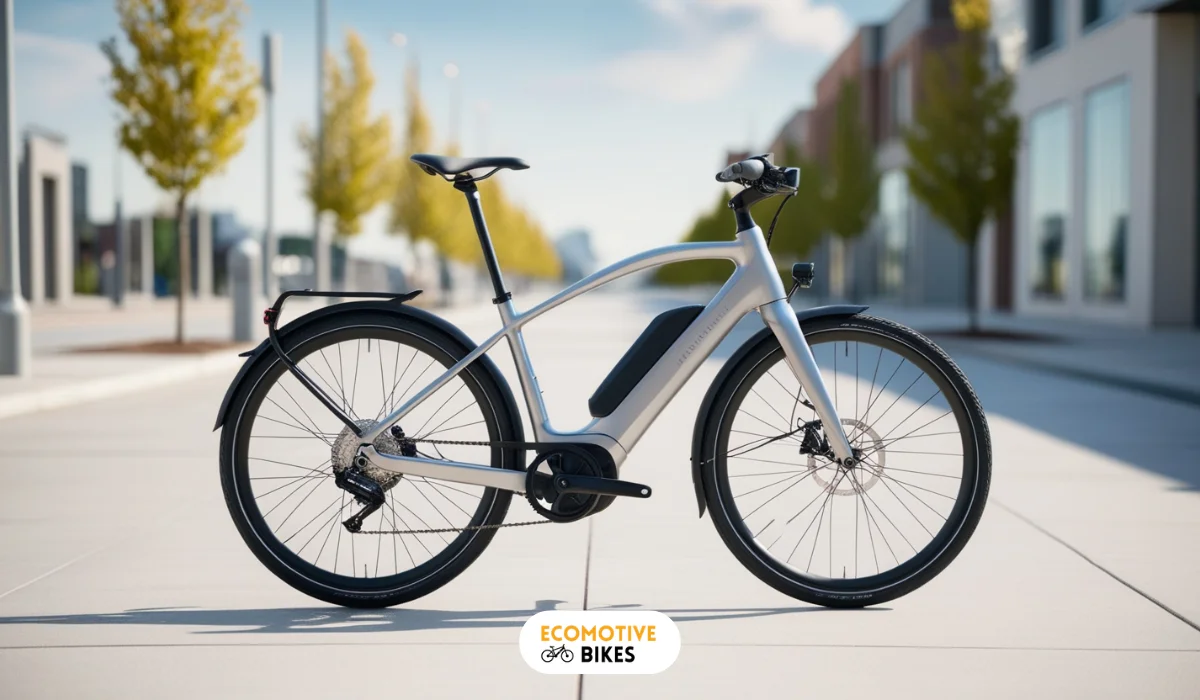Disc Brake vs V Brake vs Rim Brake: Which is Best for Your Bike?
Disc brake vs V brake vs Rim brake for e-bikes. Learn about their performance in various weather conditions, maintenance needs.
Table of Contents
Related Articles:
Disc brakes vs. V brakes vs. Rim Brakes: When choosing brakes for an e-bike or traditional bicycle, understanding the differences between disc, V, and rim brakes is crucial to optimize performance, safety, and comfort. Each brake type has unique strengths and limitations, such as how well they perform in different weather conditions, the maintenance they require, and their compatibility with various tire widths.
This guide will break down the advantages and drawbacks of disc, V, and rim brakes across key aspects, helping you decide which braking system best meets your riding needs and budget.
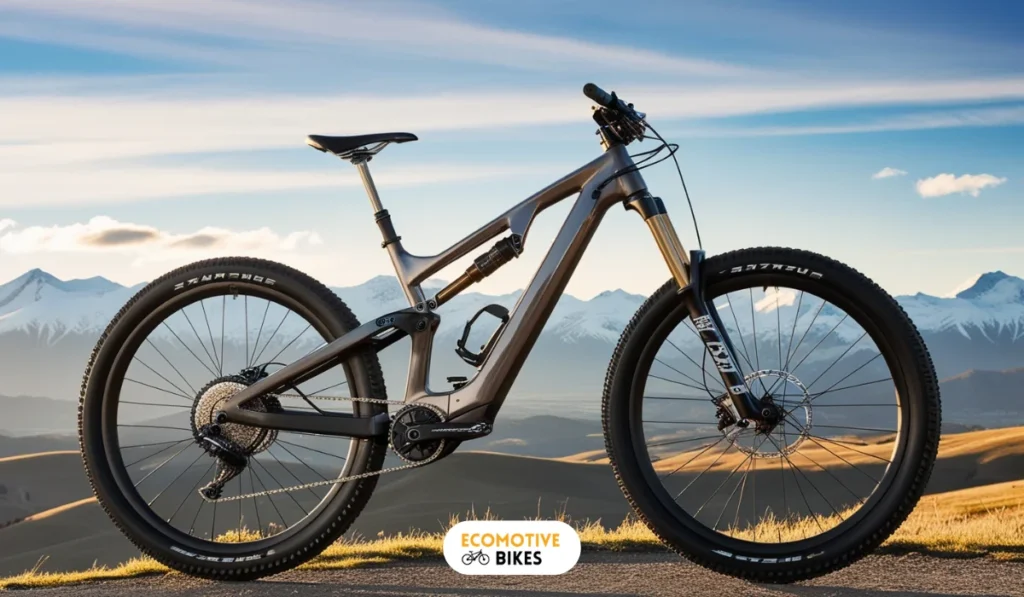
What is a Disc brake?
A disk brake on an electric bike is a braking system that uses a metal disc, or rotor, attached to the wheel hub. When the rider applies the brake lever, calipers equipped with brake pads squeeze the rotor, creating friction that slows down the wheel.
This type of brake provides consistent stopping power, especially in wet or muddy conditions, due to its design being less affected by debris or weather compared to rim brakes. Disk brakes can be mechanical, where a cable activates the brake pads, or hydraulic, which uses fluid pressure for smoother, more responsive braking.
Advantages of disc brakes for e-bikes
- Stronger braking power: Disc brakes provide more consistent and stronger stopping power, especially beneficial for e-bikes, which tend to be heavier and faster than traditional bicycles.
- Effective in all weather conditions: Unlike rim brakes, disc brakes maintain their braking efficiency in wet or muddy conditions. The braking surface is further from the ground, reducing the impact of water, dirt, or debris.
- Less wear on wheels: Since disc brakes don’t rely on the wheel rim for stopping, they don’t wear down the rim over time, extending the life of the wheels.
- Better modulation: Disc brakes allow for smoother control and more precise modulation, meaning you can apply just the right amount of braking force. This helps prevent sudden stops or skidding, improving safety on varied terrain.
- Heat dissipation: Disc brakes are designed to dissipate heat more effectively. This prevents brake fade during prolonged braking, such as when going downhill, ensuring consistent performance.
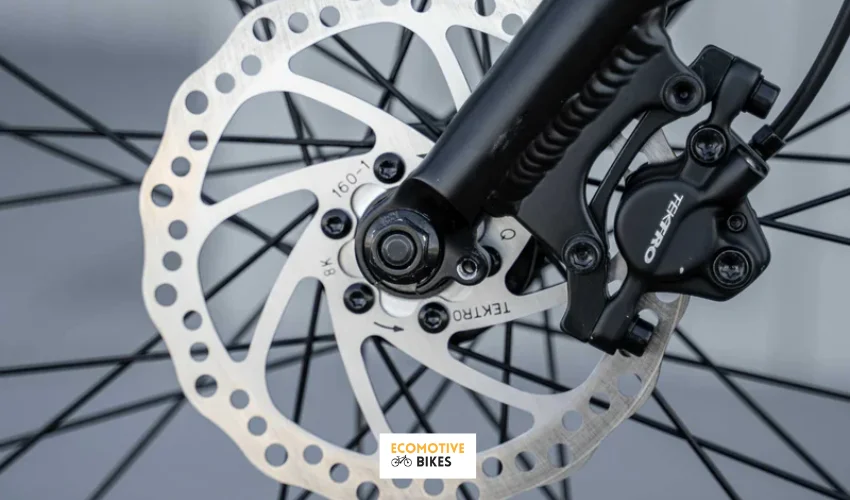
Disadvantages of disc brakes for e-bikes
- Heavier weight: Disc brake systems are generally heavier than rim brakes, adding extra weight to the e-bike. This can slightly reduce battery range or affect handling.
- More expensive: E-bikes with disc brakes tend to be pricier due to the added complexity and superior performance of the braking system.
- More maintenance: Disc brakes may require more regular maintenance than rim brakes, especially hydraulic disc systems, which need periodic fluid replacement and potential adjustment.
- Complex installation and repairs: Installing or repairing disc brakes can be more complicated, often requiring specialized tools and expertise, making it less beginner-friendly for bike owners who prefer DIY maintenance.
- Potential for rotor damage: The exposed brake rotor can be prone to bending or damage if the bike falls over or experiences a hard impact, which can affect braking performance.
What is a V brake?
A V-brake, also known as a linear-pull brake, is a type of rim brake commonly found on bicycles, including some electric bikes. It consists of two brake arms mounted on either side of the wheel, with pads that press against the rim to slow down or stop the bike. When the rider pulls the brake lever, the arms are pulled together by a cable, pressing the pads against the wheel rim.
V-brakes are known for their simplicity, ease of maintenance, and strong braking power, especially in dry conditions. However, they can be less effective in wet or muddy environments compared to disk brakes, as they rely on the wheel’s rim for stopping power.
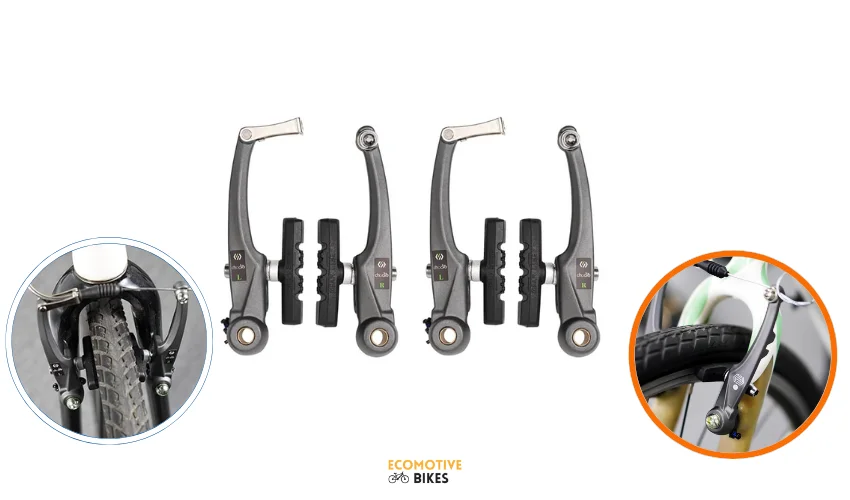
Advantages of v-brakes for e-bikes
- Lightweight: V-brakes are lighter than disc brake systems, making them a good choice for those who prioritize weight and want to maximize the efficiency and range of their e-bike.
- Affordable: V-brakes are typically less expensive than disc brakes, making them a more budget-friendly option. They also have lower maintenance costs, as replacement pads and parts are usually cheaper.
- Simplicity and ease of maintenance: V-brakes are relatively simple to maintain and repair. Riders can easily replace the brake pads without specialized tools, and adjustments are straightforward, making them an accessible option for DIY bike maintenance.
- Wide compatibility: V-brakes are compatible with most standard bike frames and wheels, making them versatile and easier to install on a variety of e-bikes without significant modifications.
Disadvantages of v-brakes for e-bikes
- Less effective in wet conditions: V-brakes rely on friction with the wheel rim, which can reduce braking power in wet or muddy conditions. This makes them less reliable in adverse weather compared to disc brakes.
- Increased rim wear: Since V-brakes use the rim as the braking surface, frequent braking can wear down the rim over time, eventually requiring wheel replacement or repair.
- Limited braking power: V-brakes are generally less powerful than disc brakes, which can be a disadvantage on heavier e-bikes or when riding in steep or demanding terrain.
- Heat build-up: During prolonged braking, such as downhill riding, V-brakes can generate heat, leading to brake fade and reduced effectiveness over time.
What is a Rim brake?
A rim brake is a type of braking system commonly used on bicycles, where the brake pads press against the wheel’s rim to slow down or stop the bike. The system typically consists of two brake arms positioned on either side of the wheel, connected by a cable to the brake lever on the handlebars. When the rider squeezes the brake lever, the cable tightens, pulling the arms together and causing the pads to clamp down on the wheel rim.
Rim brakes are lightweight, cost-effective, and easy to maintain, but they can wear out the wheel rim over time. They may also be less effective in wet or muddy conditions, as water or dirt can reduce friction between the pads and the rim, impacting stopping power. Despite these limitations, rim brakes remain a popular choice for many types of bicycles, including some electric bikes.
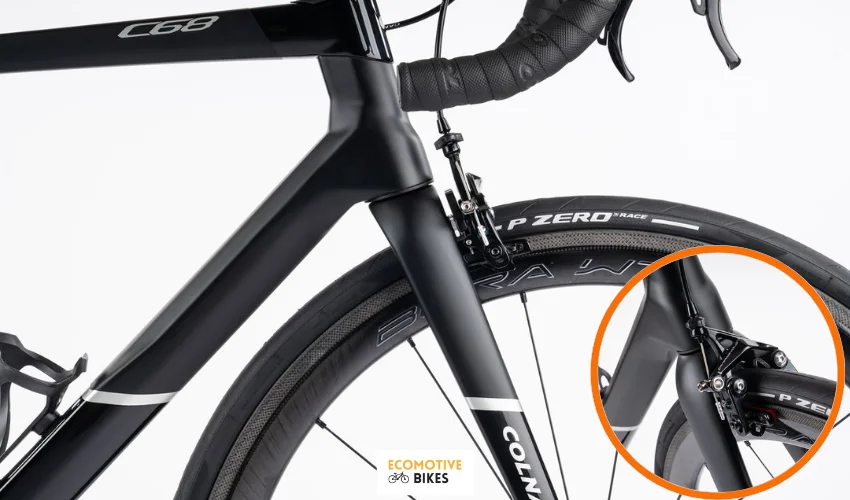
Advantages of rim brakes for e-bikes
- Lightweight design: Rim brakes are one of the lightest brake options available, which can help keep the overall weight of the e-bike down. This contributes to better battery life and handling.
- Cost-effective: Rim brakes are typically more affordable than both disc brakes and V-brakes. Replacement parts like brake pads are also inexpensive, making them economical for long-term use.
- Simple to maintain: Like V-brakes, rim brakes are easy to maintain and repair. Brake pads can be replaced quickly without needing specialized tools, and adjustments are generally simple, making them suitable for DIY riders.
- Widely available: Rim brakes have been used on bikes for decades, so they are widely available and compatible with many e-bike models. This makes it easy to find parts or perform upgrades.
Disadvantages of rim brakes for e-bikes
- Reduced performance in wet conditions: Rim brakes rely on direct contact with the wheel rim, which can become slick in wet or muddy environments. This decreases braking efficiency and can make stopping less reliable.
- Rim wear: Continuous use of rim brakes leads to wear on the wheel’s braking surface, eventually necessitating wheel replacement. This can increase long-term maintenance costs.
- Lower braking power: Compared to disc brakes, rim brakes offer less stopping power, especially when handling heavier e-bikes or navigating steep inclines. This can affect overall safety in more demanding conditions.
- Heat management issues: Rim brakes can heat up during extended braking, leading to brake fade. Since they don’t dissipate heat as efficiently as disc brakes, this can impact performance during long descents or frequent stops.
E-bike Brakes: Disc brake vs V brake vs Rim brake
We have already seen the advantages and disadvantages of Disc, V, and Rim brakes. Let us check all these brakes on some parameters to see who the winner is.
1. Weather conditions
- Disc Brakes: Disc brakes are highly reliable in all weather conditions, especially in wet and muddy environments. Since they apply braking force at the rotor rather than the rim, they remain unaffected by rain or debris, delivering consistent stopping power.
- V-Brakes: V-brakes can struggle in wet weather due to their direct contact with the rim. Water or mud on the rim surface reduces friction, which decreases braking efficiency and increases stopping distances.
- Rim Brakes: Similar to V-brakes, rim brakes lose effectiveness in wet conditions as the slippery rim surface reduces the grip between the brake pad and rim, making it harder to stop.
Winner: Disc Brakes
2. Tire clearance
- Disc Brakes: Disc brakes allow for larger tire clearance, enabling the use of wider tires. This improves traction and comfort, especially when riding on rough terrain, as wider tires can handle lower pressure better.
- V-Brakes: V-brakes generally offer less tire clearance compared to disc brakes, restricting the width of tires that can be used, limiting comfort and adaptability to rough surfaces.
- Rim Brakes: Rim brakes also limit tire width, typically accommodating narrower tires (up to 28mm), making them less versatile for different terrains.
Winner: Disc Brakes
3. Reliability and maintenance
- Disc Brakes: Disc brakes, particularly hydraulic systems, are more complex and may require professional servicing. However, they are durable and deliver reliable performance over time with minimal wear on the rims.
- V-Brakes: V-brakes are easier to maintain, with simple mechanical components that can be adjusted on the go. This makes them a practical choice for riders seeking ease of use and low maintenance.
- Rim Brakes: Rim brakes, like V-brakes, are easy to maintain, but frequent use wears down the rims, requiring more replacements over time. Their simplicity, however, makes them accessible for most riders.
Winner: V-Brakes/Rim Brakes (for ease of maintenance)
Related: Squeaking e-bike brakes
4. Wheels
- Disc Brakes: With disc brakes, the braking system is independent of the rim, which helps extend the lifespan of the wheel. This also allows for more advanced wheel designs, giving the bike better durability and performance.
- V-Brakes: V-brakes wear down the rim over time as they apply direct pressure. This reduces the wheel’s lifespan and might lead to more frequent rim replacements.
- Rim Brakes: Rim brakes face the same issue as V-brakes, where repeated use can lead to rim damage or excessive wear, particularly during long descents.
Winner: Disc Brakes
5. Aesthetics
- Disc Brakes: Disc brakes tend to have a bulkier appearance, which may detract from the sleek, streamlined look of certain bikes. However, newer models have improved this with hidden cables and sleeker designs.
- V-Brakes: V-brakes offer a minimalistic and clean appearance, with less visible hardware compared to disc brakes. This gives the bike a more traditional and uncluttered look.
- Rim Brakes: Rim brakes are also favored for their simplicity in design, contributing to a classic, streamlined appearance that appeals to cyclists who value aesthetic simplicity.
Winner: V-Brakes/Rim Brakes
6. Axles
- Disc Brakes: Bikes equipped with disc brakes generally require thru-axles to provide the added rigidity that enhances stability and braking power, especially at high speeds. However, thru-axles make wheel changes a bit more complicated and slower, which can be challenging for quick adjustments or repairs on the go.
- V-Brakes: V-brakes are compatible with quick-release axles, making wheel removal and replacement quick and simple. This feature is advantageous for casual riders, allowing them to address flat tires or other issues more easily.
- Rim Brakes: Like V-brakes, rim brakes are typically compatible with quick-release axles, which allow for efficient wheel changes. This feature suits riders looking for convenience and ease, especially during roadside repairs.
Winner: V-Brakes/Rim Brakes
7. Cost
- Disc Brakes: Disc brake systems, especially hydraulic ones, are typically more expensive to purchase and maintain. This higher cost can be a deterrent for budget-conscious buyers but is justified by their superior performance.
- V-Brakes: V-brakes are more affordable, both in terms of the initial setup and ongoing maintenance. They provide a cost-effective solution for riders who prioritize simplicity without sacrificing functionality.
- Rim Brakes: Similar to V-brakes, rim brakes are budget-friendly and offer low-cost maintenance. While they may require more frequent rim replacements, their overall cost remains lower than disc brake systems.
Winner: V-Brakes/Rim Brakes

Here is a table that shows the differences between Disc, V and Rim brakes on an e-bike:
| Parameter | Disc Brakes | V-Brakes | Rim Brakes |
| Weather Conditions | Highly effective in all weather, especially wet or muddy; braking force applied at rotor, not rim | Can struggle in wet conditions due to water or mud on the rims but works well in dry weather | Less effective in rain as wet rims reduce friction, affecting stopping power |
| Tire Clearance | Allows for larger tires, offering improved comfort and traction on rough terrain | Limited tire clearance compared to disc brakes, restricting maximum tire width | Generally restricted to narrower tires (up to ~28mm), limiting versatility |
| Reliability & Maintenance | Complex, especially hydraulics; durable but requires skilled maintenance | Simple mechanics make them easy to maintain and adjust; ideal for everyday riding | Simple to maintain but frequent rim wear means more replacements |
| Wheels | Keeps rims intact and allows for advanced designs; no rim wear from braking | Rim wear over time, leading to eventual rim replacement; rim quality affects braking performance | Similar to V-brakes; wear and excessive heat can damage rims, especially on long descents |
| Aesthetics | Can be bulky, though hidden-cable models offer a cleaner look | Minimalistic, contributing to a cleaner appearance | Classic and streamlined, favored by riders who prefer a traditional aesthetic |
| Axles | Typically requires thru-axles for added rigidity, making wheel changes slower | Compatible with quick-release axles, making wheel changes quick and convenient | Works with quick-release axles, enabling fast wheel changes |
| Cost | Generally higher initial and maintenance costs, particularly for hydraulic systems | More budget-friendly, affordable to install and maintain | Similar to V-brakes; budget-friendly with low-cost maintenance |
Conclusion: Differences between Disc, V and Rim Brakes
Selecting the right brake type—disc, V-brake, or rim—depends on your specific needs and riding conditions.
Disc brakes provide reliable, consistent braking in all weather conditions, making them ideal for diverse environments and riders prioritizing control.
V-brakes offer simplicity and lower maintenance, making them a practical, budget-friendly choice, while rim brakes excel in delivering a streamlined, traditional look and a lightweight setup.
Evaluating these differences in the context of where and how you ride will help you make the best choice, whether for an e-bike or a classic bicycle setup.

